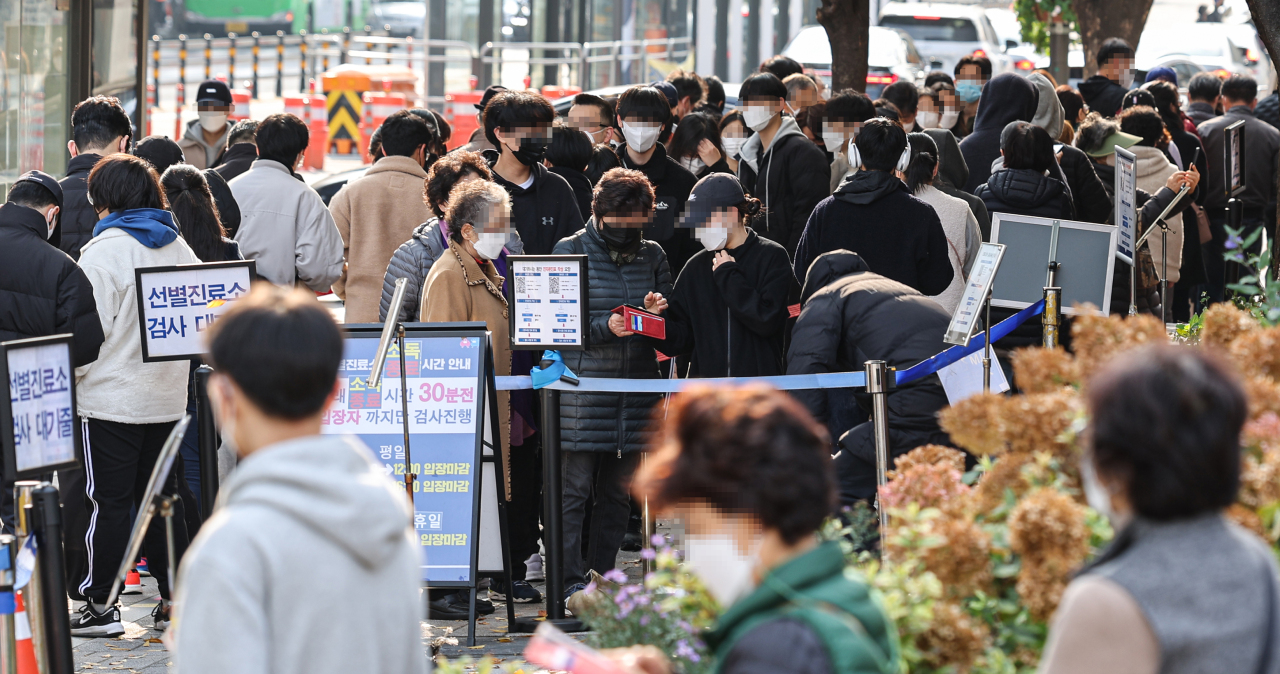Two weeks into Korea’s “living with COVID-19” scheme, the number of critically ill patients in intensive care is inching closer to the government’s threshold.
The number of coronavirus patients undergoing intensive care treatment reached 483 as of Saturday, according to the Korea Disease Control and Prevention Agency. The figure is just short of the record high of 485 reported on the previous day.
Of the 483 critically ill patients, 82.2 percent were over the age of 60, raising concerns about the increasing trend of elderly people becoming severely ill with COVID-19.
The government has said it would be able to stably handle up to 500 critically ill patients who require intensive care treatment such as continuous renal replacement therapy, extracorporeal membrane oxygenation, high flow oxygen therapy and being put on a ventilator.
The number of critically ill patients has shown a steady growth since the start of November when the country began shifting toward normalcy with eased restrictions on operating hour limits and social gatherings.
According to the KDCA’s data, 343 people were undergoing intensive care treatment on Nov. 1. The figure went up to 411 on Nov. 6 and reached 460 on Wednesday. Sunday marked the ninth day in a row the figure has stayed above 400.
The country has recently also seen more COVID-related deaths. The KDCA on Sunday reported 20 deaths from Saturday, bringing the total caseload to 3,103 with the fatality rate at 0.78 percent. Of the 20 deaths, 60 percent were 80 years or older while the rest of the group were aged between 60 and 79.
Friday’s death tally, 32, marked the highest daily figure since Jan. 8 when 35 people died from the virus.
The country reported 2,419 new cases of the coronavirus from Saturday, marking the fifth consecutive day for the daily total to stay above 2,300. Seoul, Gyeonggi Province and Incheon accounted for nearly 80 percent of the daily confirmed cases nationwide.
With the majority of cases being reported in the Greater Seoul area, the capital region’s health care system is being stretched to near capacity.
According to the Central Disaster Management Headquarters, 76.2 percent of Seoul’s intensive care beds were occupied as of Saturday 5 p.m., surpassing the government’s threshold for activating a contingency plan. The occupancy rates were 73.4 percent for Incheon and 71.9 percent for Gyeonggi Province. Across the country, the rate stood at 59.6 percent.
The government previously said reaching a 75 percent ICU bed occupancy rate would be one of the standards for putting a stop to its “living with COVID-19” plans and bringing back curfews and toughening social gathering guidelines.
The KDCA on Sunday reported that a total of 4,278 people, who showed either mild or no symptoms after they were infected with the virus, were treating themselves at home. Of them, 94.3 percent were in the Greater Seoul area. Health experts fear that it may lead to a surge in the number of patients who develop severe symptoms while at home.
“Many people who are treating themselves from home are breakthrough cases. If the elderly over the age of 60 have shortness of breath, they have to get to the emergency room by themselves,” said Dr. Chun Eun-mi, a respiratory disease specialist at Ewha Womans University Medical Center.
“When the condition of patients treating from home gets worse, related medical institutions or medical workers should transfer them to designated hospitals or care facilities. But that is not being done at all right now. Maybe it’s because I have seen only part of the whole situation, but what I was worried about is happening right now.”
The number of people isolating at home will likely rise, and those who do not receive proper treatment could develop severe symptoms, she added, and will lead to more deaths.
The KDCA on Friday announced that it had provided 38,000 self-treatment kits for local governments and plans to supply a total of 300,000 by January. A self-treatment kit includes a pulse oximeter and thermometer. Patients record their health condition with the devices, while medical staff can remotely check their temperatures and oxygen saturations.
By Kan Hyeong-woo (
hwkan@heraldcorp.com)








![[Today’s K-pop] Blackpink’s Jennie, Lisa invited to Coachella as solo acts](http://res.heraldm.com/phpwas/restmb_idxmake.php?idx=644&simg=/content/image/2024/11/21/20241121050099_0.jpg)